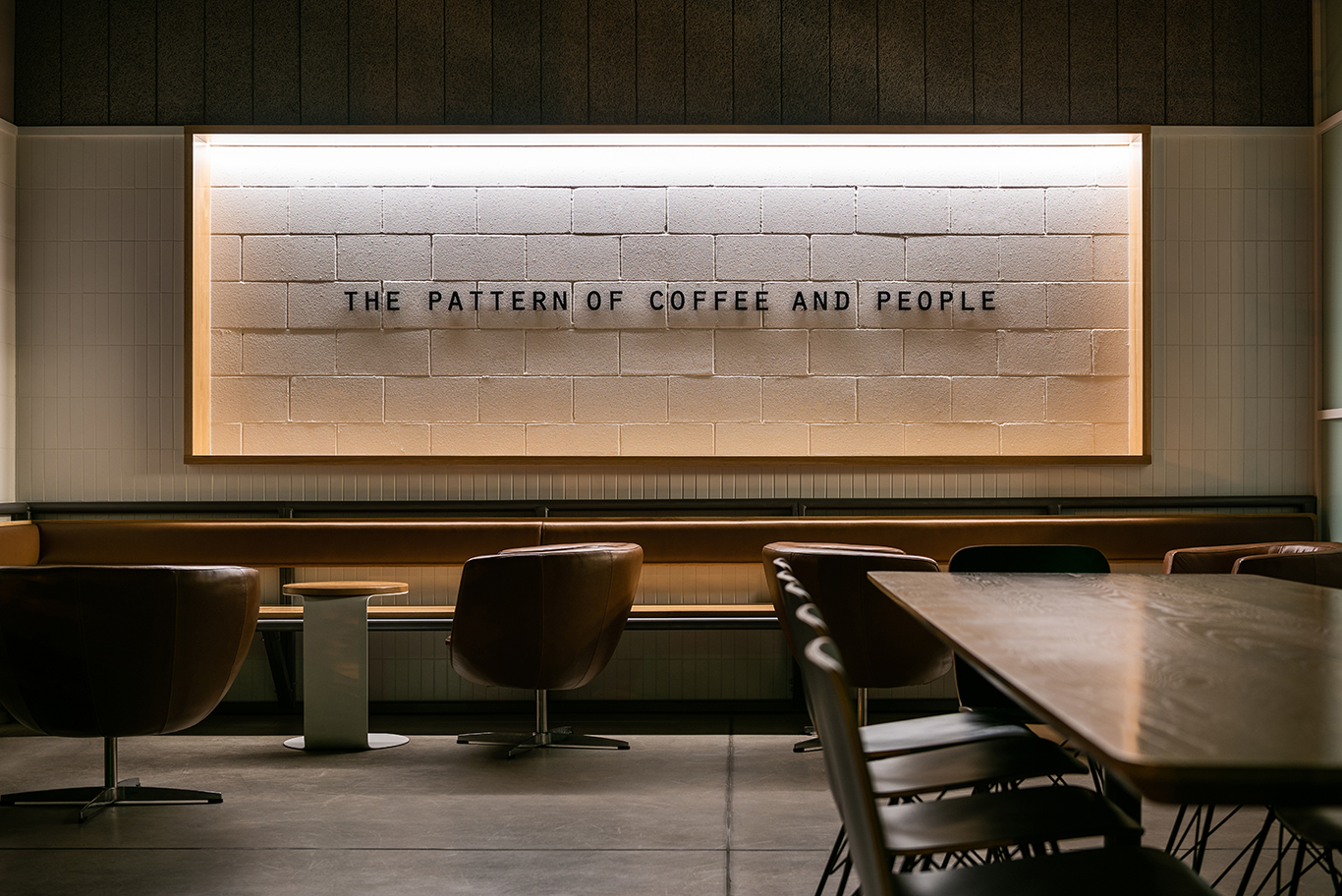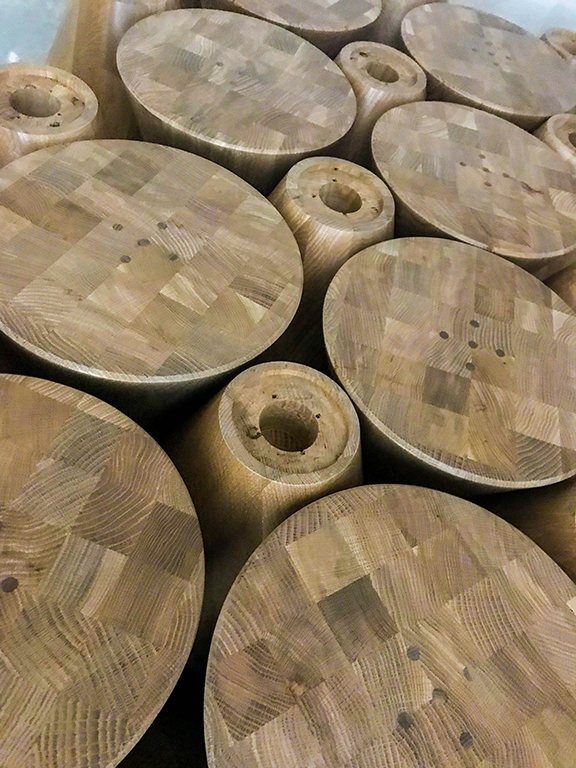CHARACTERIZING Craft
 Photo by Robert Yu
Photo by Robert Yu
Amy is army-crawling through the tiny attic of a new residence that our studio just completed in Austin. Dimmable driver clutched in her mitts, she is focused on the final wiring connections for the two 8-foot-long LED lights that the general contractor and I are holding while precariously perched on the kitchen island below. One by one they illuminate, and then I hear her yell, “Are they on?” and “Woo-hoo!” when we confirm.
We’re an architecture firm, and we design furniture and lighting. Sometimes we fabricate the pieces in our workshop, and sometimes we oversee fabrication by others. Both are creatively satisfying. Neither are easy. We often work on the installation as well, which is how Amy ended up in the attic.
Six years ago, we envisioned our studio as a place where all of our interests and skill sets could be engaged. We both trained as architects and met in architecture graduate school at the University of Texas at Austin. I have an MFA in furniture design. We have both studied woodworking and are versed in digital tools. Our firm’s architectural work includes small- and large-scale residential, commercial and retail interiors, and a collection of other projects. The variety of project types and scales keeps us interested and enthusiastic. The goal of our studio is to maintain an environment where creativity is encouraged because creativity is what makes our work distinct. In our studio, that creativity is expressed through craft.
Had you asked 10-year-old me what craft meant while I was helping my father build side tables in his two-car garage, I probably would have told you it was about eased edges or evenly applied homemade tung oil. Maybe a perfectly chiseled mortise and tenon. If you’d asked me during architecture school, I would have said something involving 220 grit sandpaper.
Turns out craft is a tricky word and perceived in a multitude of ways. Craft is ambiguous and does not have a singular definition. Creative expression is just one interpretation. Among other things, craft is the ingenuity and the will required to bring your ideas to reality. Craft is also the skillful navigation of the existing manufacturing and distribution systems, or the critical craft of communication. Craft is elastic. Craft is an amorphous concept dependent upon scale, budget, and project type, and propelled by designer and client. Craft is an ever-evolving organism that is perceived differently by all who pursue it.
An enormous component of executing creative ideas is having the confidence that the idea can be achieved. Understanding the necessary trades, craftspeople, processes, and techniques required to get something fabricated is essential.
Thomas Heatherwick discusses his background and how his knowledge of varied trades freed him to explore bigger ideas: “My training allowed me to move freely between materials and processes that included working with plastics, glassblowing, welding, jewelry-making, ceramics, embroidery, and timber joinery. Exploring different scales of problem-solving, I was able to pursue my ongoing interest in the design of buildings and the built environment. … My experience making my own design ideas convinced me that understanding materials, and gaining practical experience of using them, was essential to developing ideas and finding ways of making them happen.”

Creativity in craft is strongest when the depth of experience described by Heatherwick merges with creative ideas to find a unique solution to a design problem. For instance, we designed a custom bolt-down stool for a client who wanted a seat that didn’t need to be reset after every customer and could be installed at multiple heights for different seating options. The stool consists of two parts, a conical white oak seat that reads as an extruded end-grain cutting board and a round steel tube with plate base, designed to bolt to the floor. We were interested in exploring the quality of raw metal, but with the durability of a finished material. The default finish for a piece like this would be a metallic paint, which looks fake because it is, or blackened steel, which did not jibe with the overall project.
But knowing that the first stage of the powder-coating process is to sandblast the metal in preparation for the powder finish, we decided we could achieve the desired aesthetic with a sandblasted steel and a clear matte powder coat that is normally reserved for the top layer over a standard finish. We called multiple powdercoaters to explain our idea, were turned away by many, and found one willing to do it.
The process required more detailed, uniform sandblasting and then a concerted effort not to touch the steel between the sandblasting and the coating phase, as the oils of fingerprints linger and quickly rust freshly sandblasted steel.
To the delight of everyone involved, the result was what we set out for — a clean look with textured depth and a unique finish. It sounds simple, but that is craft at its best: understanding the processes involved well enough to know where the subtle shifts can occur to achieve something special.
Sawdust Studio in Austin took our original idea of the wooden seat being turned on a lathe and carved it with a router on a custom jig. The metal fabricator did all the welding and CNC cutting of the steel components. The powder-coater was willing to take a chance on an untested process. The project’s general contractor connected the craftspeople to us and the client. We all discussed the ideas in detail, reviewed and critiqued the shop drawings, examined the mock-ups, and celebrated the final install.
Crafting special pieces requires special people. Being able to work effectively and communicate respectfully with other craftspeople in an informed manner is essential to making projects come to life.
Zooming out from our limited-run stool, we talked with Ryan Anderson of RAD Furniture about his take on craft. Ryan, who has a master’s degree in architecture from UT, started his furniture company in 2010 and now distributes his work nationally. We’ve used his pieces in multiple projects because we like everything about them — not just the design but also the ease of working with Ryan and his team from the initial order to the shipping and customer service. They take what they do seriously, and we greatly appreciate it.
“Craft is a foregone conclusion,” he told us. This statement caught Amy and me off guard. He emphasized that people simply expect products to be well-fabricated and well-executed. That is the foregone conclusion. Ryan sees craft as the successful navigation of the full range of craftspeople, material suppliers, distribution systems, buyers, and others as necessary to take a project from design and raw materials to RAD’s furniture landing on site.
His craft includes constantly calibrating the logic of his inhouse fabrication systems, from the order of welds to joint types. An extra 30 seconds blending a weld can have a detrimental effect on his profit margin when multiplied by 1,000 orders. Within his craft, he is exacting efficiencies in the metal shop while still maintaining the design integrity and quality of his work. In RAD’s case, craft is an endeavor of continuous improvement.
Which highlights one of the most important qualities a designer must have to craft unique work at any scale: tenacity. Designs always encounter what we refer to as chronological design obstacles, as in once you overcome one design obstacle, you unceremoniously push on to the next. Then another and another until your work is finally complete.
It is tempting to give up after too many obstacles. It’s easier to choose a standard design solution or an off-the-shelf option. A good balance of confidence and stubbornness is paramount to see projects through to the end. Tenacity applies to work at all scales, from furniture to architecture.

Los Angeles firm Marmol Radziner runs its studio in the form of a traditional master builder to enhance the quality of its craft and creativity. Here’s why: “While the standard concern of design-build is that architects hold back on designs when they know they are responsible for building, we find the opposite to be the case. We challenge ourselves as craftspeople and builders to take the rigor of designing a project and extend it into the execution of complex conditions.” Rather than fearing the challenges, Marmol Radziner has chosen to design more rigorously, implementing an all-encompassing team that includes architects, metal fabricators, carpenters, and a full general construction crew to create architecture rich with well-crafted detail.
As academics and multiple design competitions have taught Amy and me, drawing something awesome is easy. Craft is an ever-expanding library of skills that we apply and build upon over a lifetime. Our individual experiences, our professional development, the project types we’ve taken on, and our interactions with the others with whom we share the construction and fabrication all add to, embody and enrich our characterization of craft.
This article originally appeared in the Autumn 2018 “Craft” issue of AIA Dallas Columns magazine.